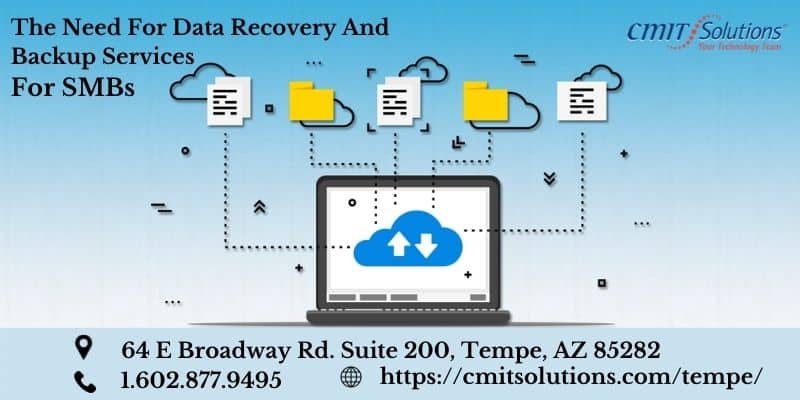Who keeps IT systems up to date? How should an IT solution budget be set up? How can IT increase the productivity of staff and the way businesses are now run? What IT considerations should companies be thinking about in the future? Should they hire a managed IT service provider like CMIT in Tempe? Should they keep IT in-house? These are some of the many raging questions businesses ask.
Information Technology plays an extremely crucial part in business operations today. With the advent of remote working in the Covid-19 era, its significance has increased manifold. So, obviously, there would be plenty of talks and discussions about it. Managed IT services versus having the IT guy in-house is one of the most crucial and important ongoing debates.
What is a Managed Service Provider (MSP)?
The managed service provider (MSP) is an outsourced service provider that remotely administers an end-IT user’s infrastructure and applications. MSPs are employed by small & medium-sized businesses (SMBs), governmental organizations and non-profit organizations to perform a specified range of ongoing tasks related to IT management. Infrastructure and networking management, security, and monitoring are some of their services. Needless to say, these are essential to the overall operations of all organizations!
Who is An IT Support Person?
An IT Support person, unlike the MSP, is an employee of your company. However, having such an individual on the payroll is not often considered unless your business involves a lot of technology. One reason is that it is not the most cost-effective course of action to keep anyone on your company payroll who is not a standard requirement. Additionally, you will be constrained by the knowledge and abilities of the team members.
How to Decide What Your Organization Needs?
Larger businesses with more complex internet systems will hire a team of experts offering comprehensive and varied IT solutions. Small companies or startups do not want to take this route since they focus more on the monthly cost than the rewards. One typical line of thought is: What if this month goes without any IT issues? Funnily enough, you end up wishing for some IT issues to get something in return for your money!
Here, we highlight some of the key issues to assist you in choosing between MSP and an in-house guy: –
Necessary skill sets
If you want to outsource your company’s IT to an MSP, one of the critical considerations is the skill sets needed for the functions. An individual will have the support of a group of diversely skilled people. You receive a varied, modern, and innovative solution when you work with an MSP.
MSPs will also constantly train their staff to keep them abreast of emerging technologies. You can make use of this updated expertise without paying the additional training fees you may incur for an internal employee.
Ease of operations
The break-fix approach allows you to employ top experts for your problems, but finding them and bringing those on board requires time. To hire an MSP, you need to approach (phone call or email) them, explain your issue, and they’ll send someone right away to fix it.
Employing a person in charge of IT could be an excellent strategy for some. A full-time worker has a better chance of connecting with the employees and the IT needs of the company. Naturally, being so approachable fosters better communication and deeper understanding.
Current organizational needs
Depending on the current business needs, you may quickly scale up or downsize your operations with MSPs. With an in-house IT service, it can be challenging to scale up internal IT services since you have to identify, hire, and educate new employees. An internal IT team faces a different set of challenges while scaling down. Internal staff may be overworked or underworked as a result of scalability problems.
Impact on the budget
The break-fix strategy is typically used by enterprises in the hope that it may help them save money, but in reality, they usually end up spending much more than they would have if they had chosen an MSP. MSP indeed charges a monthly fee. However, this fee is fixed. You won’t have to spend a penny higher than that, regardless of the number of services you request from them or how complex their duties may be.
The expense of paying the salaries for a single internal IT team is substantially higher. Since IT is a field that is rapidly changing and expanding, you’ll need to continuously train your IT crew to keep them up to date on the most current industry standards. The cost of the training will be higher. If you choose in-house personnel, there are costs related to office space, utilities, infrastructure expenses, equipment, and procedures.
Ease of access
Employees working on-site will only be accessible during regular business hours. Off-hours emergencies in IT are also possible. A managed IT service company may offer you after-hours support if you so desire. Support in after-work hours may include the provision in your contract. MSPs will also provide cover for an ill worker or on leave. Their staff members can serve as internal workers and handle client-facing duties as de facto employees. Thanks to the skills and training development initiatives, MSPs can rapidly become familiar with your company and integrate seamlessly with it.
A team of professionals is also available from MSPs for consultation for networking and server architecture, regular maintenance jobs, software and equipment integrations, encryption, and hardware acquisitions. The synergy of skills available is difficult to replicate in a single individual; if it were possible, that person would probably demand a high salary.
With regular IT employees, you will need to plan training sessions and substitute workers in case of absence, which involves additional costs. Information Technology is an ever-evolving field; hence, IT employees must always remain updated. Other expenses in having an in-house IT team include office space, utilities, infrastructure, and equipment costs, to name a few.
Takeaway
If the simple questions in life had simple answers, too, everything would be seamless. When you are running a business, you face new challenges every day. With increased competition and the race to get ahead, companies can get ahead even by the tiniest changes they make in their modus operandi. In a nutshell, this is what it comes down to!
Business managers and owners need to be intelligent and adaptive. They must field the right horse in the right race at the right time. It all comes down to your company and what it needs. Doesn’t it make more sense to get top-notch IT services while you spend your precious time running your business?
A managed IT service provider is all you need for creative, skillful, and inventive IT without adding unnecessary expenses and thinning your bottom line. So, what are you waiting for? Call CMIT, Tempe, right away!
Our IT Services
| Managed IT Services | Cybersecurity | Productivity Applications |
| IT Support | Cloud Services | Network Management |
| Compliance | Data Backup | Unified Communications |
| IT Guidance | IT Procurement |




